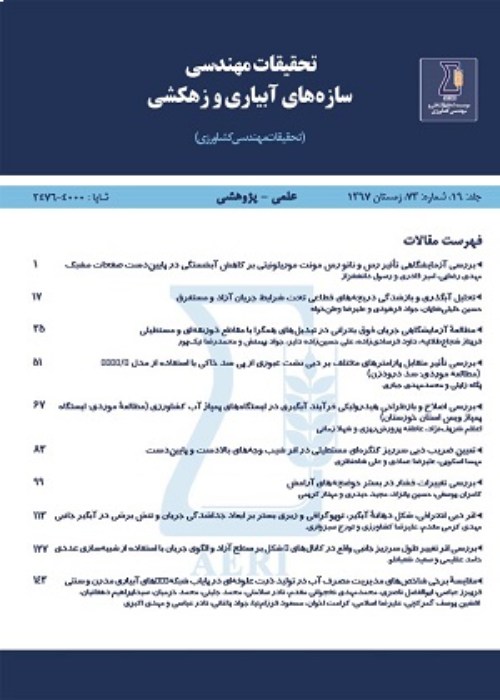Optimization of Height and Length of Ogee-Crested Spillway by Composing Genetic Algorithm and Regression Models (Case Study: Spillway of Balarood Dam)
The cost of dam construction is very high. A lot of dams are broken due to the water passing through dam crest. The most important factor which causes this is, insufficient spillway capacity. The aim of present study was investigating optimal height and length for Ogee-Crested spillway because such height and length minimizes the cost of spillway construction. In order to determine objective function, the spillway length variations were considered in the range of 10 to 30 m and the flood return period was estimated in the range of 1000 to 10,000 years. Optimization was done with using genetic algorithm in MATLAB software environment. In fact, the aim of this study was investigating the effect of height and length of spillway on the cost of spillway construction, therefore, Analytical relationships presented with using regression model. The main function of Ogee-Crested spillway is providing ideal conditions for passing designed flood from upstream to downstream. Bagatur & Onen in 2016, used gene expression planning (GEP) models as an alternative approach to predicting appearance features and spillway design coefficients and therefore, proposed new relationship, for Ogee-Crested spillway. It was found that GEP is much better than regression model for predicting Ogee-Crested spillway characteristics. Haghbin in 2015 proposed that using multi-objective genetic algorithm can optimize spillway geometrical dimensions. The results of this study provide the appropriate height and length for the spillway.
The question of this research is, what is the appropriate height and length for the Ogee-Crested spillway of Ballarood Dam? In this study, the Ballarood Reservoir Dam was selected as a case study and genetic algorithm process was used for optimizing this issue. First, objective function was coded and then, this function was added to the MATLAB software. In order to provide Spillway cost function, spillway length variations were considered within the range of 10 to 30 m. In modeling with using genetic algorithm method, first, the length component was divided into discrete data which included integer numbers from 10 to 30.Keeping in view each optimization problem has its decision variables, constraints, and objective function. The decision variables of this present study, namely the Ballarood Dam spillway decision variables, included height (P), length (L), and flood return period (T). The models derived from algorithm modeled with using regression, and their meaningful level was obtained.
In this study, after determining objective function and choosing suitable operators, optimization was done with using genetic algorithm; the most appropriate response was reported as problem answer. Considering the maximum design load (Hd = 50.50 m) and (T = 10000 years), the optimum dimensions and costs were obtained by function: The optimal spillway length and height was was found to be 14.4 m and 47.31 m respectively.It needs to be mentioned that the designed Ballarood Dam spillway is 20 meters in length. With optimization by genetic algorithm, this length was reduced to 14.4 meters. Comparison of the results showed that if this amount of spillway had been applied during construction of the dam, it could have saved up to 28% on project implementation economically. The output value for the spillway height in this study was 31.47 m and the operational value for the height was 47.7 m. Comparison of these two data indicates 34% higher altitude allocation for the margin of confidence.
One of the goals of this study was reducing costs. Keeping this in mind, the operational cost for the spillway length and height respectively were 31% and 28% more than designed values, with reduction of spillway length and height, operational costs was greatly reduced. The other goal of this study was optimizing dimensions of spillway but according to the principles of genetic algorithm, we could not achieve to 100% of this goal. In the other words, the genetic algorithm determines the optimal dimensions but it does not determine the best answer. According to this fact, we can find other optimal dimensions for this problem, which is possible by adding more constraints to the problem. The genetic algorithm has some weaknesses, which include: Extremely high sensitivity to the population size and mutation operators which imposes high costs on the whole project in high reliability dam construction projects. Therefore, we recommend in future dam construction studies the scholars take into consideration the issue of benefits and costs future projects along with consideration of and also the high factor of safety in dam construction projects.
- حق عضویت دریافتی صرف حمایت از نشریات عضو و نگهداری، تکمیل و توسعه مگیران میشود.
- پرداخت حق اشتراک و دانلود مقالات اجازه بازنشر آن در سایر رسانههای چاپی و دیجیتال را به کاربر نمیدهد.


